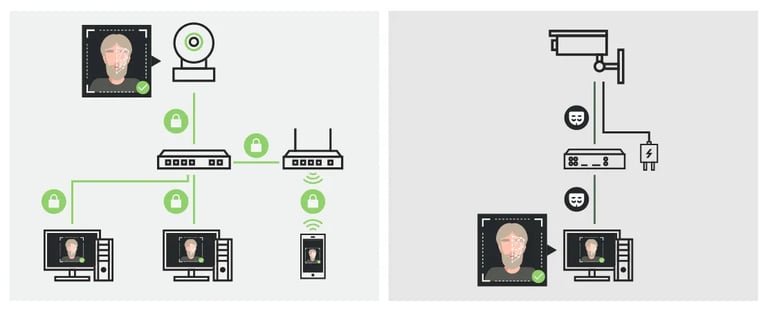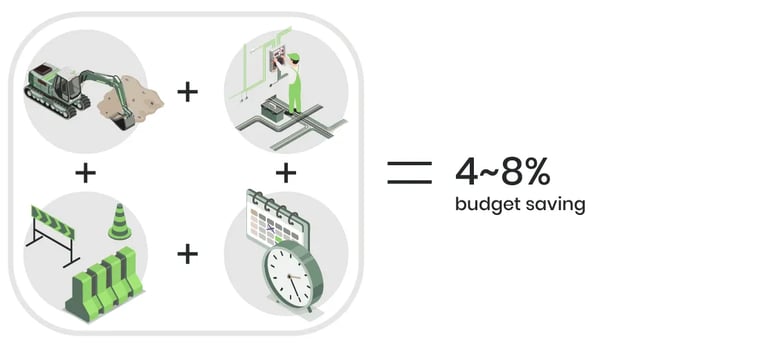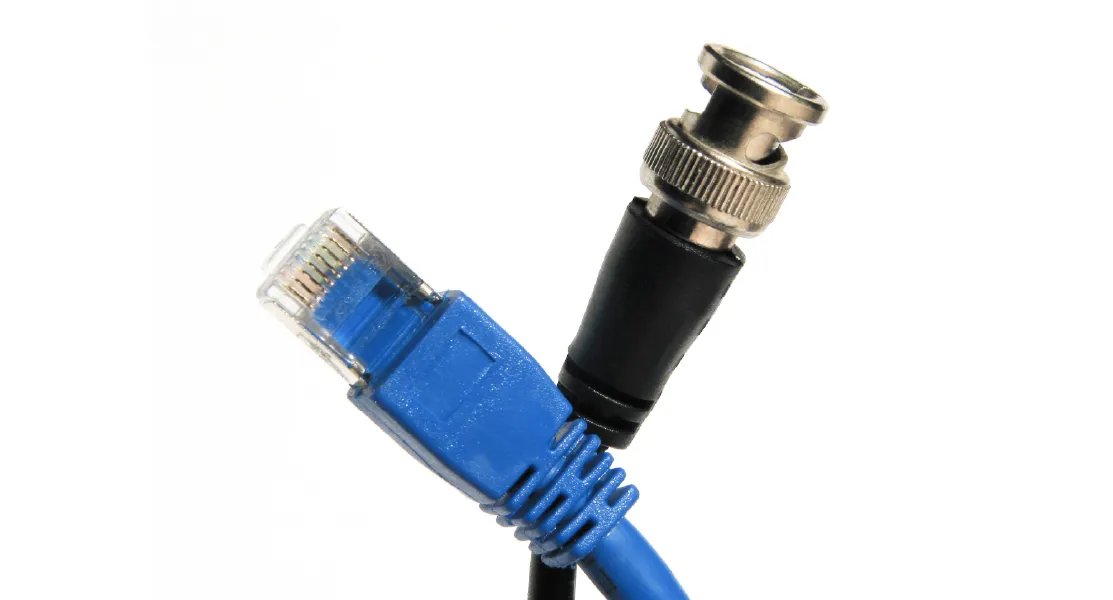
What Is Ethernet over Coax? The technology of Coaxial Cables That Helps Upgrade Security Camera Systems Effectively
What is Ethernet over Coax?
The original Ethernet technology did not use the most common twisted pair today—the first Ethernet standard 10BASE5 ThickNet in 1983 used coaxial cables for transmission. Later, however, cheaper and smaller network cables became common and gradually replaced coaxial cables in the transmission of Ethernet.
Though Ethernet using network cables is now the norm, the technique of Ethernet over Coax (EoC) is still required, for coaxial cables are widely used in security camera systems everywhere. The need to transmit network signals over the existing coaxial cables exists no matter in urban or rural areas.
Nowadays, Ethernet over Coax has different application areas with diverse standards and transmission rates, including:

- MoCA
- ITU-T G.hn
- Homeplug
IP/PoE over Coax, the technology developed to extend IP/PoE cameras' transmission distance via coaxial cables, is also derived from EoC. We'll cover more about the benefits of extending network signals over coax in the following passages.
Security Camera System

Advantages of IP Cameras
In today's security camera systems, there are two typical types of cameras: One is digital cameras, such as IP/PoE cameras; the other is analog cameras. Among them, IP cameras, which can be accessed over a network connection, have several advantages that make them gradually replace traditional analog cameras.
Low Wiring Cost
Although IP cameras are more expensive than analog cameras, IP is transmitted by network cables, which are much cheaper than coaxial cables used to transmit analog signals. Regarding wiring costs, IP/PoE cameras are more affordable than traditional analog cameras, especially when building a whole-new security camera system.

Convenient Power Supplies
Whereas traditional cameras need two separate cables to transmit power and video signal, IP cameras use PoE (Power over Ethernet), the technology to transmit power and video simultaneously via a single network cable. Thus, the tricky power supply is never a problem for IP cameras.
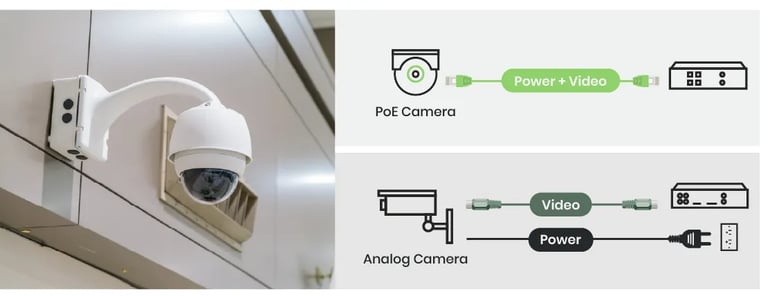
Multi-Function
IP cameras encrypt signals; this prevents video and audio from being intercepted and ensures security. In addition, an IP camera is like a mini-computer; it has functions like remote connection, license plate recognition, face recognition, etc.
High Compatibility
While there is demand for analog cameras due to the barrier of IP technology, analog camera manufacturers have continued producing new, High Definition (HD) cameras in recent years. Nonetheless, different manufacturers have developed their technology, such as CVI, TVI, and AHD, and it is unlikely to invent a new technology that can be compatible with all of them. On the other hand, IP cameras have a common network protocol worldwide; the compatibility of devices is also higher than analog HD cameras.

Challenge of Rewiring When Upgrading Security Cameras
Wear and Tear of Cables
Generally, the biggest challenge when upgrading analog cameras to IP cameras is the rewiring—replacing old coaxial cables with ethernet cables. While rewiring is never as simple as purchasing and installing new cables and equipment, it sometimes includes the following difficulties:
- Labor cost: Rewiring often involves a lot of labor.
- Space Limitation: Rewiring renders public areas unusable.
- Time-Consuming: The project can be quite time-consuming depending on the setup environment.
EoC Helps Reduce the Cost
Based on our experience, instead of replacing ethernet cables, using EoC can save the cost of new cables and reduce labor, equipment, and time expenditure, which account for 4-8% of the total project budget. Depending on the type of project, the larger project can lead to a higher cost and percentage.
In addition, a multi-input EoC device saves the cost of multiple devices. For instance, a 4-in-1-out switch allows the transmission of 4 cameras over the same coaxial cables.
Combine Existing Cabling with EoC Technology — IP/PoE over Coax
For the immense cost of upgrading the devices, matured EoC technology combined with IP cameras is considered the best solution to save the budget and reduce time. Setting up IP/PoE cameras over Coax in your security camera system only costs a short time.
Transmit Video and Network Signals
IP/PoE over Coax can be used to reduce the construction and technical cost of upgrading security devices. Only an IP/PoE extender is needed for a digital camera and network switch to work via your existing coaxial cables.
In addition, an IP/PoE extender over Coax can work as a network extender for network signals.
Advanced PoE over Coax
IC technology changes rapidly; many adapters now have IEEE 802.3 at/af/bf specification. In addition to network signals, coaxial cables can carry power for cameras as network cables can.
Highly Expandable
The original coaxial cable can work with an IP/PoE over Coax extender and connect to a network switch, which means that multiple IP cameras can be set up at the location where only one analog camera can be placed. You can add more nodes as long as it is within the bandwidth limit.
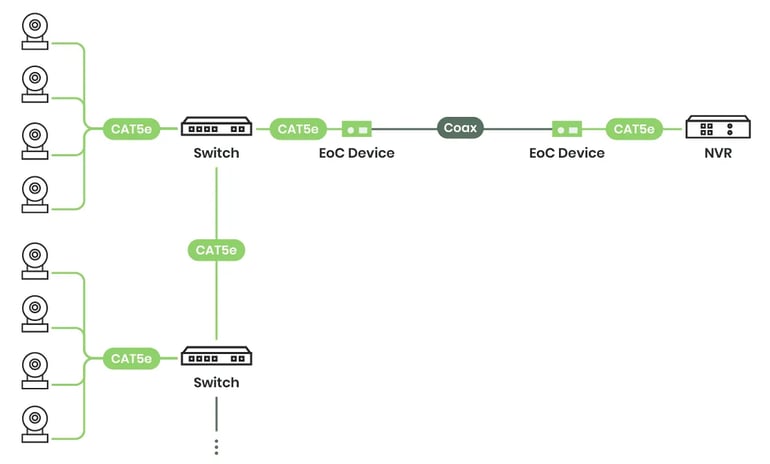
PoE Extender over Coax Installation Video
EoC & IP/PoE over Coax FAQ
Types and Quality of Coaxial Cables
Types of Coaxial Cables
While ethernet cables are divided by bandwidth, coaxial cables are classified by their cores. Coaxial cables with a higher number have thicker cores and are less likely to degrade signals and power.
When only a short transmission distance and low-frequency signals are required, RG59 is often the choice, while RG6U and RG11 are specifically for low distortion and long transmission distances.

Difference of Material
Coaxial cables with solid copper will provide a more stable signal and power than copper-clad steel cables.
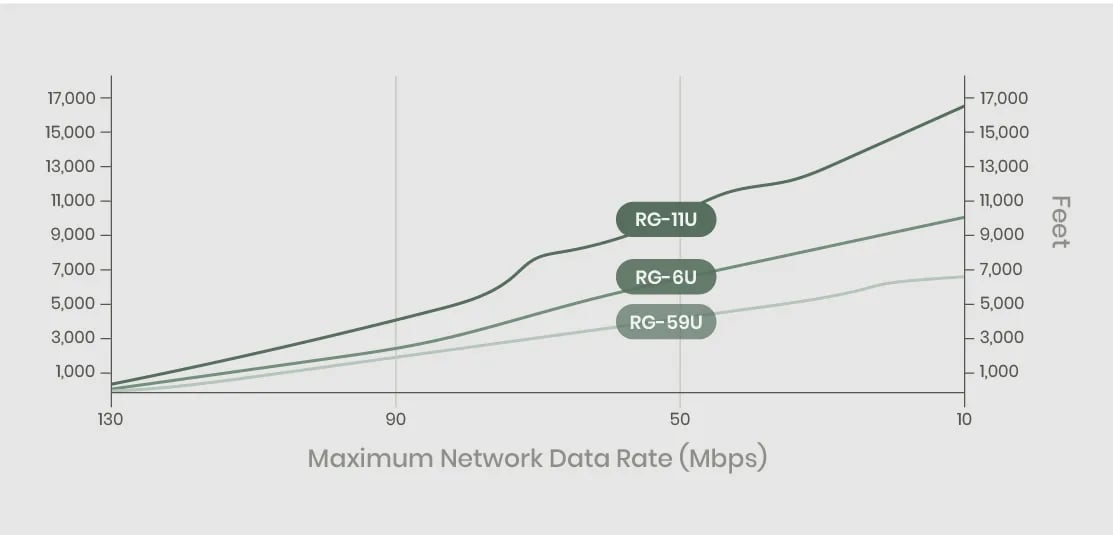
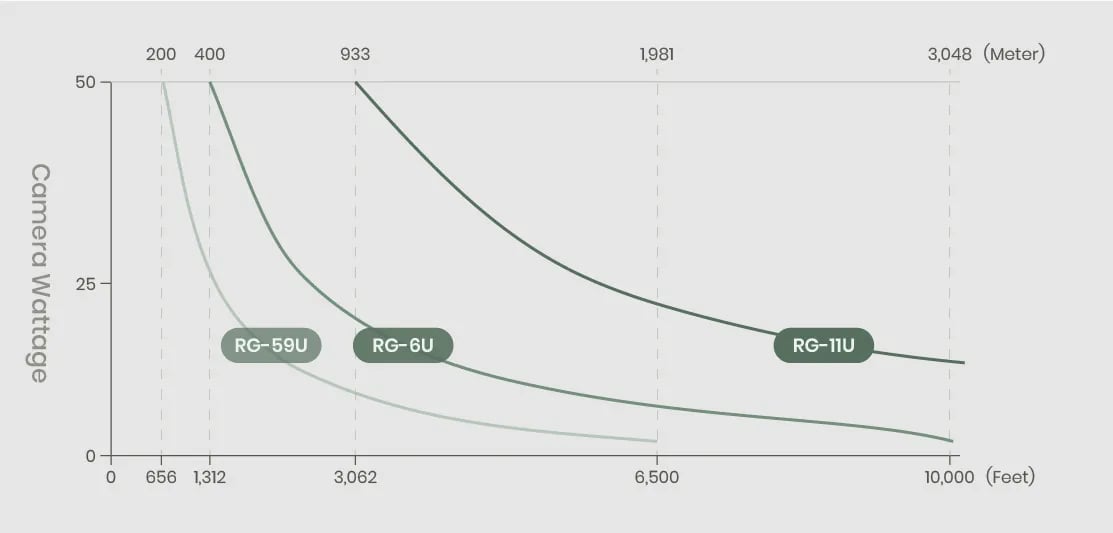
How Ethernet over Coax is Used
EoC equipment is mostly employed to upgrade ethernet devices without replacing the existing coaxial cables. However, the advantages of coaxial cables bring more opportunities for EoC.
For instance, coaxial cables' cores are shielded and have good resistance to interference. Depending on the thickness of the core, a coaxial cable's price, efficiency, and transmission distance may differ. In terms of better coaxial cables such as RG6U, the transmission distance, and quality are superior to general ethernet cables.
Where to Apply Ethernet over Coax Equipment
Cheaper ethernet cables are adequate for small and medium-sized businesses and households; they are compatible with different devices even without adapters.
In large companies, however, the use of coaxial cables to transmit network signals can ensure consistent signal quality and long transmission distance. Moreover, coaxial outlets are common in European and American households, and the cable company may use coaxial cables to transmit TV signals to the TV set or box. You may thus require EoC equipment to connect these devices.

How to Supply Power over Ethernet
In addition to the specifications of power supplies and PoE cameras, you also need to check the specification of coaxial cables. As mentioned, coaxial cables degrade power and signal differently. Some manufacturers may test the cables and record the watt in manuals for their users.
As long as the power provided is higher than the power consumed, PoE cameras can function properly.

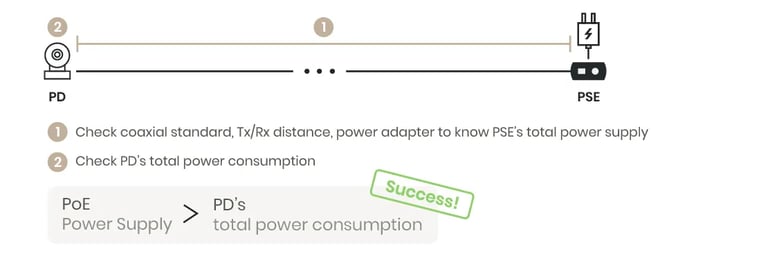
PoE Switch as Power Supply
Using a PoE switch is the simplest way to supply power. Most PoE switches are now IEEE 802.3 at standard, 1 port, with a maximum amount of 30W. Take one of SC&T's solutions for instance. An IEEE 802.3 at PoE switch can only provide 12W at a distance of 800m over RG6U coaxial cables. Remember to check the detailed specifications in user manuals before applying the product.
Use a PoE Injector
- PoE cameras connected with a non-Poe switch
- PoE switches with inadequate power supplies
To solve the above problems, you can use a PoE Injector to connect a power supply and send the needed power to your cameras.
For example, SC&T's IP09CP can be used as a PoE injector to supply power to PoE cameras at either Tx or Rx. You only need to connect an IP09CP between the PoE camera and the inadequate switch.
Mind the Total Amount of Power
In addition to the specifications of PD (Power Device) and PSE (Power Sourcing Equipment), you should also note that cables, distance, and power adapters can affect the maximum power supplies.

Suppose there are 4 IEEE 802.3 at PoE cameras (9W power consumption) and a set of IP09CPHK extended for 300m via RG6U coaxial cables, with a 56V 102W power adapter at Rx. The total power output is 44W at Tx, and after calculating the power loss, it can provide 40W for PDs, which is higher than the total consumption of 36W. This is an ideal power supply solution.
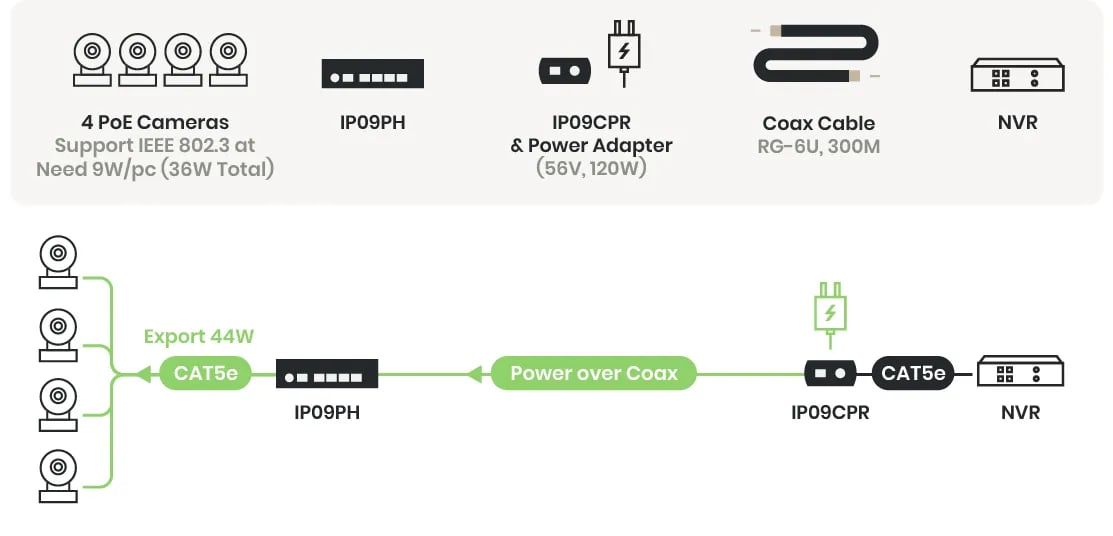
When one of the cameras is replaced by an IEEE 802.3 af PoE camera of 25W power consumption:
25 x 1 + 9 x 3 = 52 (W)
Since the amount of 52W exceeds the maximum of 40W, you will need to connect a power adapter at Tx (IP09PH), which makes it a PSE to supply adequate power.
IP09PH (Tx) Total Output Wattage Comparison

PSE & PD Comparison

Technical Support and Cautions
Adapters and Converters
Adapters use different media to transmit signals. The signal from the transmitter and the signal transmitted to the receiver is mostly the same, such as IP/PoE over coax devices.
Converters change signals completely; you can convert RS232 to ethernet, for instance.
Note that an IP/PoE over Coax device cannot function as a converter.


Be aware of Oxidation
Coaxial cable connectors are more likely to oxidize, and signals cannot pass through the oxidized connectors. Therefore, it can be necessary to trim off the oxidized parts and re-install the BNC connectors for use.
SC&T IP/PoE over Coax Products


